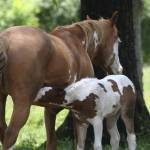Feeding the Mare and Foal after Weaning

Weaning is a stressful time for foals and mares. While mares are often ready to say good-bye to their rambunctious, rowdy charges, foals can be far more fretful. As such, weaning rarely negatively impacts a mare. In fact, some mares may blossom and begin to flesh out once they are freed from the burden of milk production. The foal, conversely, often enters a growth slump immediately following weaning. Therefore, proper nutrition is paramount.
The Weanling
Foals are typically weaned at four to six months of age. Prior to weaning, the foal should be accustomed to eating solid feed. This is usually not a problem as many foals are dipping into their dam’s feed tub by a week or so of age, although few are drinking significant amounts of water by this time as milk is satisfying their fluid needs. Many foals are introduced to creep feeding by two months of age, a time when milk begins to decrease and often no longer fulfills the nutritional needs of the foal. Creep feeding serves two purposes: to guarantee the weanlings’ nutritional needs are being met and to familiarize weanlings with eating grain so feeding time will be less stressful once separated from their dams.
How the foal is fed following weaning often depends greatly on what is expected of it in the following months. A weanling destined for the show or sale ring later in the year, for example, would be managed much more intensely than one being raised as a performance prospect, where maximal growth and condition are not as imperative. Regardless of their eventual use, the primary goal of feeding all weanlings is the same–steady, even growth. In order for the weanling to achieve optimal growth, sufficient dietary energy must be supplied. Weanlings cannot consume enough forage to satisfy energy requirements for steady growth.
Therefore, grain must be fed. Generally, 1 to 1.5 pounds of grain per day per month of age are recommended for weanlings of horse breeds. Pony weanlings would receive less, about 0.5 to 0.75 pounds per day per month of age. Grain provides the energy, protein, and minerals necessary to compensate for those not present in the forage. In addition, the grain should have sufficient levels of lysine, an amino acid essential for proper growth. Grain mixes made with soybean meal, canola meal, or an animal-source protein are preferred because of their high lysine content. The requirement for lysine has been reinforced by research over the years. In one study, weanlings fed a diet with sufficient protein but insufficient lysine in the form of cottonseed meal experienced slower growth rates than peers fed cottonseed meal with added lysine or soybean meal as the protein supplements in the diet.
A grain concentrate appropriate for a weanling on pasture or fed a legume-mix hay (such as an alfalfa blend) will generally contain 14% crude protein. Some horsemen that are feeding strictly grass hay will provide feeds with 16% or 18% crude protein. Feeding mild excesses of protein does not cause bone problems, as many people think it does.
Adequate forage should be offered to make up for energy deficiencies between the weanling’s energy needs and that provided in the grain. The safest way to achieve this is by allowing the weanling access to all of the nonlegume forage it will consume. Feeding legume forage is acceptable, but weanlings should not be allowed unrestricted access to it. Rather, they should be fed enough to provide sufficient digestible energy for moderate to rapid growth.
Feeding too much legume forage is no different than feeding too much grain. Either way, excessive intake of dietary energy results. Some researchers believe such feeding practices contribute to developmental orthopedic disease (DOD). If a legume or a legume-grass mix forage is used, the amount of grain fed may be reduced to limit energy intake. A weanling normally fed 1 pound per month of age per day may be reduced to half that amount.
Like many adult horses, some weanlings are easy keepers and likely to become overweight on even minimal amounts of grain. In these cases, weanlings can be fed a low-calorie, low-intake source of essential protein, vitamins, and minerals, without feeding excessive energy.
As with all horses, weanlings should have unlimited access to water and salt. If there is inadequate copper, zinc, and selenium in the grain, a trace-mineralized salt high in these minerals may be used. When depending on a free-choice supplement to supply these minerals, adequate intake is essential.
The Mare
Much emphasis is placed on the foals during the weaning process, and little attention is often paid to the mares. While it is true that mares, particularly those that have had previous foals, tend to weather weaning more calmly than their foals, nutritional changes in mares should not be forgotten.
In an effort to slow milk production, some horsemen stop feeding mares grain five to seven days before weaning and keep them off until their udders have dried up. The consumption of highquality forages is reduced to that typically consumed by nonlactating mares. Decreasing milk production as quickly as possible will keep mares more comfortable. Although it may be tempting, do not milk out mares, as this will only provoke further milk production.
If a mare is in adequate body condition following weaning, she can be turned out on good quality pasture and managed similarly to barren or early pregnant mares. If lactation has reduced the body condition of the mare to the point where she is thin, grain and high-quality forage, such as a legume or legume-grass mix, can be fed to facilitate weight gain.
Nutritional mistakes made early in the lives of horses can lead to structural problems that may limit performance potential. Therefore, proper nutrition of the post-weaning foal is critical. Just as important is the careful management of mares following the weaning of their foals. Getting or keeping mares in optimal body condition may increase future reproduction efficiency.








